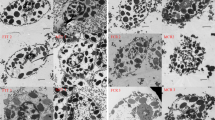Summary
The structure of hemocytes in the normal state and during blood coagulation, and the intracellular localization of three clotting factors and two antimicrobial factors were examined in the Japanese horseshoe crabTachypleus tridentatus. Two types of hemocytes were found in the circulating blood: non-granular and granular hemocytes. The latter contained numerous dense granules classed into two major types: L- and D-granules. The L-granules were larger (up to 1.5 μm in diameter) and less electron-dense than the D-granules (less than 0.6 μm in diameter). The L-granules contained three clotting factors and one antimicrobial factor, whereas the D-granules exclusively contained the other antimicrobial factor. After treatment with endotoxin, the L-granules were released more rapidly than the D-granules, although almost all granules were finally exocytosed. The granular hemocyte possessed a single Golgi complex; possible precursor granules of L-granules and D-granules contained tubular and condensed dense material, respectively. These data are discussed in relation to the self-defense mechanisms of the horseshoe crab.
Similar content being viewed by others
References
Armstrong PB (1985) Adhesion and motility of the blood cell ofLimulus In: Cohen WD (ed) Blood cells of marine invertebrates: experimental systems in cell biology and comparative physiology. Liss, New York, pp 77–124
Armstrong PB, Rickles FR (1982) Endotoxin-induced degranulation of theLimulus amebocyte. Exp Cell Res 140:15–24
Bauchau AG (1981) Crustaceans. In: Ratcliffe NA, Rowley AF (eds) Invertebrate blood cells, vol 2. Academic Press, London, pp 385–420
Bursey CR (1977) Histological response to injury in the horseshoe crabLimulus polyphemus. Can J Zool 55:1158–1165
Copeland DE, Levin J (1985) The fine structure of the amebocyte in the blood ofLimulus polyphemus. I. Morphology of the normal cell. Biol Bull 169:449–457
Dumont JN, Anderson E, Winner G (1966) Some cytologic characteristics of the hemocytes ofLimulus during clotting. J Morphol 119:181–208
Fahrenbach WH (1970) The cyanoblast: hemocyanin formation inLimulus polyphemus. J Cell Biol 44:445–453
Mürer EH, Levin J, Holme R (1975) Isolation and studies of the granules of the amebocytes ofLimulus polyphemus, the horseshoe crab. J Cell Physiol 86:533–542
Muta T, Hashimoto R, Miyata T, Nishimura H, Toh Y, Iwanaga S (1990) Proclotting enzyme from horseshoe crab hemocytes: cDNA cloning, disulfide locations and subcellular localization. J Biol Chem 265:22426–22433
Nakamura S, Iwanaga S, Harada T, Niwa M (1976) A clottable protein (coagulogen) from amoebocyte lysate of Japanese horseshoe crab (Tachypleus tridentatus): its isolation and biochemical properties. J Biochem 80:1011–1024
Nakamura T, Morita T, Iwanaga S (1985) Intracellular proclotting enzyme inLimulus (Tachypleus tridentatus) hemocytes: its purification and properties. J Biochem 97:1561–1574
Nakamura T, Horiuchi T, Morita T, Iwanaga S (1986a) Purification and properties of intracellular clotting factor, factor B, from horseshoe crab (Tachypleus tridentatus) hemocytes. J Biochem 99:847–857
Nakamura T, Morita T, Iwanaga S (1986b) Lipopolysaccharide-sensitive serine-protease zymogen (factor C) found inLimulus hemocytes: isolation and characterization. Eur J Biochem 154:511–521
Nakamura T, Furunaka H, Miyata T, Tokunaga F, Muta T, Iwanaga S, Niwa M, Takao T, Shimonishi Y (1988) Tachyplesin, a class of antimicrobial peptide from the hemocytes of the horseshoe crab (Tachypleus tridentatus). J Biol Chem 263:16709–16713
Neuwirth M (1973) The structure of the hemocytes ofGalleria mellonella (Lepidoptera). J Morphol 139:105–124
Ornberg RL (1985) Exocytosis ofLimulus amebocytes In: Cohen WD (ed) Blood cells of marine invertebrates: experimental systems in cell biology and comparative physiology. Liss, New York, pp 127–142
Ornberg RL, Reese TS (1981a) Beginning of exocytosis captured by rapid-freezing ofLimulus amebocytes. J Cell Biol 90:40–54
Ornberg RL, Reese TS (1981b) Comparison of compound with plasmalemmal exocytosis inLimulus amebocytes. Methods Cell Biol 23:301–311
Ratcliffe NA, Price CD (1974) Correlation of light and electron microscopic hemocyte structure in Dictyoptera. J Morphol 144:485–498
Ravindranath MH (1980) Haemocytes in haemolymph coagulation of arthropods. Biol Rev 55:139–170
Ravindranath MH (1981) Onychophorans and myriapods. In: Ratcliffe NA, Rowley AF (eds) Invertebrate blood cells, vol 2. Academic Press, London, pp 327–354
Rowley AF, Ratcliffe NA (1976) The granular cells ofGalleria mellonella during clotting and phagocytic reactions in vitro. Tissue Cell 8:437–446
Rowley AF, Ratcliff NA (1981) Insects. In: Ratcliffe NA, Rowley AF (eds) Invertebrate blood cells, vol 2. Academic Press, London, pp 355–384
Shigenaga T, Muta T, Toh Y, Tokunaga F, Iwanaga S (1990) Antimicrobial tachyplesin peptide precursor: cDNA cloning and cellular localization in horseshoe crab (Tachypleus tridentatus). J Biol Chem 265:21350–21354
Shishikura F, Chiba J, Sekiguchi K (1977) Two types of hemocytes in localization of clottable protein in Japanese horseshoe crab,Tachypleus tridentatus. J Exp Zool 201:303–308
Tanaka S, Nakamura T, Morita T, Iwanaga S (1982) Anti-LPS factor: an anticoagulant which inhibits the endotoxin-mediated activation ofLimulus coagulation system. Biochem Biophys Res Commun 105:713–723
Weber K, Osborn M (1979) Intracellular display of microtubular structures revealed by indirect immunofluorescence microscopy. In: Roberts K, Hymans JS (eds) Microtubules. Academic Press, New York, pp 279–313
Author information
Authors and Affiliations
Rights and permissions
About this article
Cite this article
Toh, Y., Mizutani, A., Tokunaga, F. et al. Morphology of the granular hemocytes of the Japanese horseshoe crabTachypleus tridentatus and immunocytochemical localization of clotting factors and antimicrobial substances. Cell Tissue Res. 266, 137–147 (1991). https://doi.org/10.1007/BF00678720
Accepted:
Issue Date:
DOI: https://doi.org/10.1007/BF00678720



